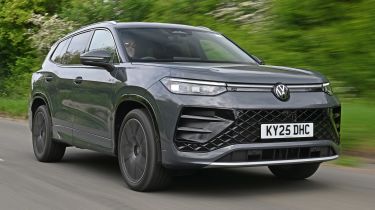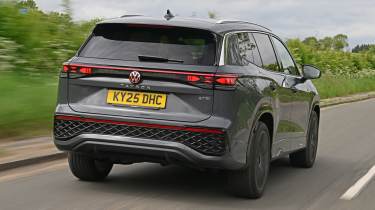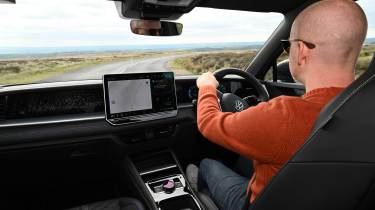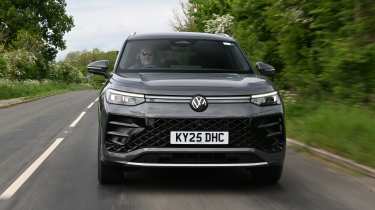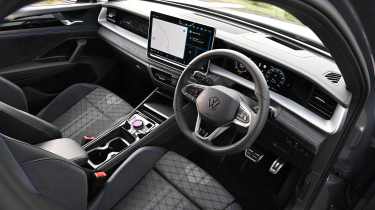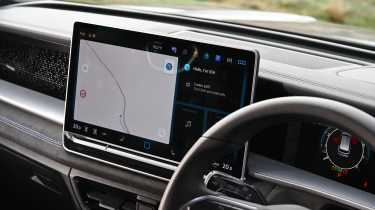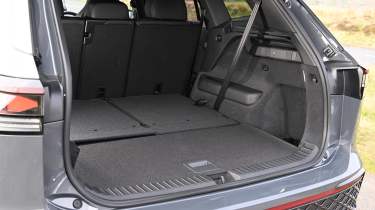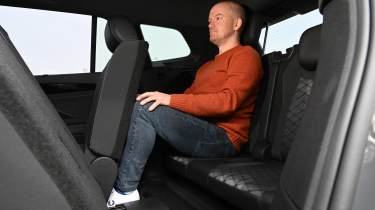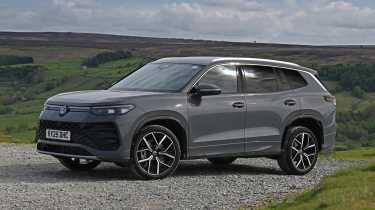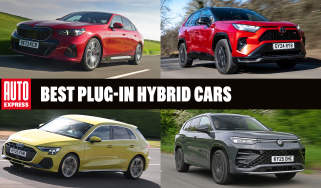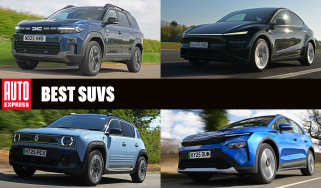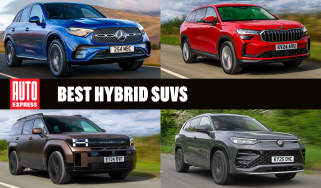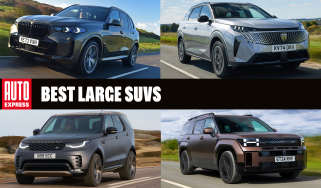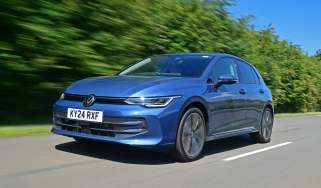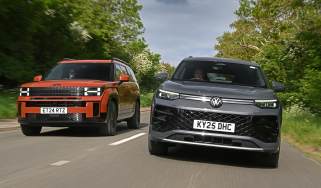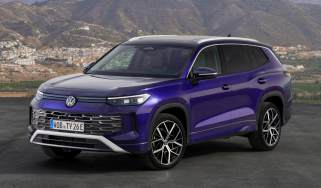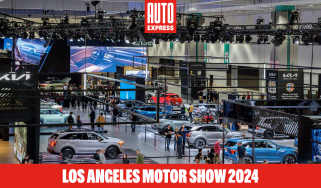Volkswagen Tayron review
The Volkswagen Tayron takes the Tiguan’s best bits and mixes them with added practicality. We think it’s a solid, if unoriginal, family car

Is the Volkswagen Tayron a good car?
The Volkswagen Tayron only really makes sense as a seven-seater – its core differentiator to the smaller, cheaper Tiguan. That means the plug-in hybrids quickly lose their appeal, despite their impressive electric-only range, because they only seat five.
It’s far from the greatest SUV to drive out there, but if your primary focus is how many people you can fit in it, then this shouldn’t have much bearing. The Tayron forms an appealing step between the Tiguan and Touareg SUVs, with the excellent kit list, strong variety of engines and solid interior standing out as real positives.
About the Volkswagen Tayron
The Volkswagen Tayron had been available in other global markets before it arrived in the UK in early 2025. It arrived here in second generation guise as a replacement for the VW Tiguan Allspace - the seven-seat version of the Tiguan. It borrows plenty of its design and technology from the Tiguan, but the Tayron is larger and its seven seats are a unique feature in Volkswagen’s range of SUVs because the flagship Touareg is five-seat only.
We’ve tested the Tayron on a wide range of UK roads and driving scenarios. We also carried out an in-depth twin-test that put it head-to-head with key rival, the Hyundai Santa Fe. The Tayron won a tight battle thanks to a superior driving experience compared to the Korean car.
Volkswagen Tayron prices and latest deals
Prices for the Tayron kick off at around £41,000 but there’s a wide range to choose from.
Used - available now

2026 Volkswagen
Tayron
7,775 milesAutomaticPetrol1.5L
Cash £41,299- Tayron Life: prices from £41,000
- Tayron Elegance: prices from £43,500
- Tayron Match: prices from £45,000
- Tayron R-Line: prices from £44,000
- Tayron R-Line Edition: Prices from £47,500
The petrol and diesel models are only available in Life, Elegance and R-Line trim with the Match and R-Line Edition levels only available with the plug-in hybrids. The plug-in system is about £3,000 more than the base petrol engine and you can expect to pay a premium of around £5,000 for the Tayron over its Tiguan sibling, model for model.
Check out our latest new car deals and leasing deals for the top offers available now on the Auto Express. Toy can spec your ideal Tayron and get offers from dealers to choose from. And don't forget we can help you sell your car, too.
Engines, performance & drive
Pros |
|
Cons |
|
Few cars in this class offer quite as much choice as the Volkswagen Tayron. Short of a fully electric option, it’s got pretty much every base covered; pure petrol or diesel, mild-hybrid and plug-in hybrid options are all on the table. The standard models are front-wheel drive but 4Motion 4x4 models are available at the top of the range.
Being based on Volkswagen’s heavily updated MQB Evo platform, the Tayron is available with optional DDC dual-valve adaptive dampers that let you alter the ride to your tastes across different driving modes, plus the latest generation of VW’s progressive power steering and the XDS virtual limited-slip differential to help the car distribute its power.
Volkswagen has tweaked the Tayron’s suspension to be softer than its ‘all-rounder’ Tiguan counterpart because the larger SUV with its seven-seat layout is designed to be a more practical, less sporty, family-focused model.
Performance, 0-60mph acceleration and top speed
The range kicks off with the 1.5 eTSI: a four-cylinder petrol engine that is backed up by a 48V lithium-ion battery and 48V belt-starter generator that replaces a traditional alternator and starter motor. While it’s a smooth enough unit and remains hushed under load, it doesn’t feel particularly lively for its 148bhp output. That’s with just one person on board, too; fully loaded with seven people and their cargo, we suspect it’ll need to be worked fairly hard to make much progress.
While diesel has largely fallen out of favour with many buyers, a big, torquey engine is exactly what this car needs. The 2.0-litre diesel offers the same power as the 1.5 eTSI but, crucially, it has a significant 110Nm more torque than the petrol. It costs roughly £1,200 more than the petrol version like-for-like, but we think that’s a worthwhile outlay.
If you and your six passengers are in a little more of a hurry, then there’s always the range-topping 2.0-litre turbo petrol unit. Essentially, it’s in the same state of tune as the EA888 engine fitted to the VW Golf GTI – with 262bhp – but here it powers all four wheels for a 0-62mph time of 6.1 seconds.
There are also a couple of plug-in hybrid models, which combine a 1.5-litre petrol engine with an electric-only range of up to a claimed 73 miles. But in order to package the 17.9kwh battery, there’s no space for the sixth and seventh seats. Despite this, the plug-in hybrids are expected to be the biggest sellers in the UK. They have 201bhp and 268bhp respectively with the more powerful version covering the 0-62mph sprint in a lively 7.3s.
The plug-in models have a six-speed automatic gearbox rather than the seven-speed unit in the other Tayrons. On the move, both gearboxes are responsive enough but can be a little too slow to swap cogs in response to throttle inputs.
| Model | Power | 0-62mph | Top speed |
| Volkswagen Tayron 2.0 TDI | 148bhp | 9.7 seconds | 129mph |
| Volkswagen Tayron 1.5 eHybrid 272 | 268bhp | 7.3 seconds | 134mph |
| Volkswagen Tayron 1.5 eTSI | 148bhp | 9.4 seconds | 127mph |
Town driving, visibility and parking
At low speeds, the body bobs around with sharp steering inputs that you’d probably expect of a jacked-up SUV with a high centre of gravity, but speed bumps and large potholes are dealt with easily – even on the larger rims found on the high-spec trim levels.
The steering is light and the Tayron’s longer wheelbase means its turning circle is 40cm greater than the Tiguan’s 11.7-metre radius. Meanwhile, the electric auto-hold handbrake feels jerky and can allow the Tayron to roll by an alarming amount between forward and reverse gears.
Country road driving and handling
The fidgeting you get at low speeds disappears as the speed increases, so the Tayron is enjoyable to drive along a twisty road. Despite the relative softness, it’s composed and capable through corners, and feels lighter on its feet than the Hyundai Santa Fe or the Kia Sorento.
There’s a reasonable degree of chassis control in flowing corners and the DCC adaptive damping system (with its 15 different modes) has a broad range of adjustability. Get too vigorous with your steering inputs, though, and the Tayron will lose composure.
The plug-in hybrid drivetrain prefers to use electric power at higher cruising speeds but Volkswagen has generally done a great job of hiding the extra weight on the battery in these Tayron models. They feel a lot like the petrol and diesel cars to drive.
Motorway driving and long-distance comfort
Once you’re up to motorway speeds the VW settles down well, managing to smother most imperfections in the road effectively. Standard-fit acoustic glass means wind and road noise is pretty hushed. Refinement is fairly dependent on what engine you choose as well. The 1.5-litre eTSI mild-hybrid doesn’t feel too stressed and grumbly, whereas the diesel is a little noisy. Although silent in EV-only mode, the plug-in hybrid’s petrol unit doesn’t cut in and out smoothly, either.
MPG, emissions & running costs
Pros |
|
Cons |
|
Being larger and heavier than the Tiguan, the Volkswagen Tayron unsurprisingly fares slightly worse on fuel efficiency and emissions, but it’s far better than the Touareg, which uses bigger, thirster V6 engines.
Thanks to its mild-hybrid system kicking in at low speeds, the Tayron 1.5-litre eTSI manages a respectable 44.1mpg on the WLTP combined cycle, which means it’s pretty competitive against other seven-seaters such as the Skoda Kodiaq, Hyundai Santa Fe and Kia Sorento. The 2.0-litre TSI with 204bhp will return 35.8mpg and the 262bhp unit gets 33.0mpg – not bad considering their use of all-wheel drive and a lack of hybridisation. The 2.0-litre diesel provides a respectable 50.9mpg – that’s slightly less than you’ll get in both the diesel Skoda Kodiaq and VW Tiguan.
| Model | MPG | CO2 | Insurance group |
| Tayron 1.5 eHybrid 204 | 696.0mpg | 9g/km | 29 |
| Tayron 2.0 TSI 4MOTION | 33.0mpg | 195g/km | 35 |
| Tayron 1.5 eTSI | 44.1mpg | 146g/km | 25 |
Electric range, battery life and charge time
For those who want to prioritise fuel efficiency, the plug-in hybrids will be the most tempting. Available on every trim level, the Tayron PHEV in its lower-powered 201bhp guise can serve up 696mpg according to Volkswagen. In the real world we achieved close to 100mpg on our tests after a mix of petrol and electric running.
The more powerful PHEV scores a little worse according to VW, at 625.9mpg, although we suspect there won’t be much between them in daily driving. You’ll want to keep the plug-in hybrid Tayron charged up regularly, not just to maintain decent fuel efficiency, but also because the 45-litre fuel tank is pretty small. Non-PHEV Tayrons get a 55-litre fuel tank instead.
Just like in the Tiguan eHybrid, if you run the battery down to below 15 per cent capacity in the Tayron, the PHEV’s electronics will favour petrol power to save the charge. Handily, there’s a fairly nippy (for a plug-in hybrid) 40kW recharge rate, allowing for a 10 to 80 per cent top-up in 26 minutes. On our tests we were able to get around 60 miles of electric-only driving on a fully-charged battery, that’s against an official figure of 73 miles.
Insurance groups
The Tayron falls between group 25 and 35, depending on trim. The 1.5 eTSI mild-hybrid petrol is in the lowest group, while the 2.0-litre TSI 265 is likely to be the most costly to insure due to the performance on offer. The diesel model starts in group 26.
Tax
All Tayrons just creep over the £40,000 mark, which makes every version subject to the luxury car VED surcharge of £425 a year, on top of the standard rate of £195, from the second year onwards.
Depreciation
Residual values are predicted to be a Tayron strong point. Industry experts at CDL predict that some models in the range will hold on to as much as 57.5 per cent of their original value after three years or 36,000 miles, with even its most pessimistic estimates placing the high-performance petrol four-wheel-drive model at just over 55 per cent. That means the new VW beats almost every seven-seat rival aside from the Kia Sorento, which manages to fare a percentage point or two better still.
Design, interior & technology
Pros |
|
Cons |
|
The Tayron may be essentially a stretched Tiguan underneath but Volkswagen has gone to the trouble of making sure that none of the larger SUV’s body panels are copied over. The result is a car that’s almost indistinguishable from the Tiguan visually.
Like that model, the Tayron comes with its ‘standard’ body kit or with the sportier stylings of R-Line trim, but there’s no getting away from the fact this is a big, bulky SUV with interior space at the top of its brief.
Paint colours for the Tayron range from a black and white ‘solid paint’ to a white ‘premium paint’ and six metallic paint finishes. Ultraviolet is the most eye-catching, a deep purple.
As with many other VWs, the Tayron’s range starts with Life trim and includes a good level of kit as standard:
- 18-inch alloy wheels
- 12.9-inch touchscreen
- 10.25-inch driver’s display
- Wireless smartphone charging
- Adaptive cruise control
- LED exterior lights
- Ambient lighting
- Rear-view camera
- Park Assist Plus
Match trim adds two panoramic sunroofs, a memory feature for park assist, an electric bootlid with gesture control and keyless entry, but it’s on the plug-in hybrids only. Elegance features 19-inch alloys as standard, along with heated and massaging front seats, a wider array of ambient lighting choices and cornering lights.
As usual, R-Line focuses on a more sporty design adding 20-inch wheels, more aggressive-looking R-Line bumpers and sport seats. The R-Line Edition is the top-spec trim and comes with a unique set of 20-inch rims, panoramic roofs front and rear, plus all the goodies found on lower trim levels. Generally, the Tayron looks very well equipped for the price.
Interior and dashboard design
The Tayron’s neat cabin design isn’t quite a class leader in terms of ergonomics or quality, but VW has ironed out some of the ergonomic flaws that have plagued its recent cars.
Those familiar with the current Tiguan will soon find themselves at home inside the Tayron, because their dashboard designs are pretty much identical. That means that it’s dominated by a large touchscreen for the most part – 12.9 inches on base models and growing to 15 inches on higher trims.
While climate controls and driver-assist settings are mostly adjusted through the screen, these are fairly easy to alter, but the physical dials used by the Skoda Kodiaq are better still. The backlit dash and door trim panels look smart, and buttons on the steering wheel are less fiddly to use than the haptic controls used by some Volkswagen models.
Materials and build quality
While the cabin finish isn’t quite at the level of the Peugeot 5008, everything feels solidly screwed together, and any scratchy plastics tend to be in areas where hard-wearing materials are needed. Trimmed door pockets suggest that VW has put plenty of thought into offering an impression of expense.
There are some small gripes. One of the cars we tested had a wood trim on the dash which looked good from afar, yet felt a little flimsy to the touch. The base Life trim also gets a rather dull silver and black colourway inside. Other than that, the Tiguan comes with plenty of solid surfaces, premium-feeling materials and a decent level of build quality.
Infotainment, sat-nav and stereo
Whatever size screen you get in your Tayron, you’ll find a crystal-clear resolution with a neat overall design to the infotainment system. As we’ve said in the Tiguan and Passat, where this screen also appears, the menu layout could be better, with a greater emphasis on the features you’ll use more often. Slider panels beneath for the climate and volume controls remain an annoyance.
The central screen and the customisable driver’s display work well together, but with wireless Apple CarPlay and Android Auto phone connectivity as standard, we’d recommend using these over the VW’s set-up.
“The Tayron has a ‘driving experience’ switch in the middle of the centre console. This rotary dial can toggle between presets from ambient lighting, volume control or driving modes. I found it worked well, with the small display in the centre and it’s a nice feature, although it works best as a simple volume knob.” - Alastair Crooks, staff writer
Boot space, comfort & practicality
Pros |
|
Cons |
|
If you’re in the market for a roomy SUV that can occasionally seat seven, then the Tayron is ideally designed for the job. If you plan to carry six or more regularly, then the Hyundai Santa Fe or Kia Sorento are likely to be a better bet as they have more space in the rear row.
Dimensions and size
The Tayron is longer than a Volkswagen Tiguan to the tune of 250mm which is where it gets the capacity for a third row of seats. The Hyundai Santa Fe is longer and wider while the Skoda Kodiaq is a bit smaller.
Dimensions comparison | |||
| Model | Volkswagen Tayron | Hyundai Santa Fe | Skoda Kodiaq |
| Length | 4,792mm | 4,830mm | 4,785mm |
| Width | 1,853mm | 1,900mm | 1,864mm |
| Height | 1,668mm | 1,780mm | 1,656mm |
| Wheelbase | 2,789mm | 2,815mm | 2,791mm |
| Boot space | 885-1,905 litres | 628-1,959 litres | 640-2,035 litres |
Seats & passenger space
As is typical of most modern Volkswagens, the Tayron’s driver’s seat and steering wheel offer a very wide range of adjustment, which means that drivers of differing shapes and sizes can make the most of what is a fairly lofty driving position. But if the front seat is jacked up high for shorter drivers, the angle of the accelerator pedal is a touch acute, which could cause a little strain on the right foot on long motorway drives.
That minor gripe aside, there’s lots of storage up front, with a cubby wide enough to store two smartphones side-by-side (with the potential for twin wireless charging), plus a deep central bin and spacious door pockets.
The second row has loads of space for three people. The cabin feels fairly wide, the seats are supportive, and knee and headroom are excellent. Some rivals offer more space, but you’re unlikely to hear many complaints from lanky occupants in the VW. A neat feature for middle-row occupants is the central armrest which has two cupholders and a tablet holder.
The third row is tighter. As with most cars in this class, the second row can slide forward to better accommodate those in the back, but even so any adult who is taller than average will find their knees pressed up against the seat backs in front. The seat base is also very close to the floor, which forces the occupants’ knees up and reduces under-thigh support.
A lack of Isofix points in the third row is a shame, but a fixing point on the front passenger seat (plus two in the second row) gives families flexibility for fitting child seats.
Boot space
Even with all seven seats in place, the Tayron has 345 litres of boot space, which is roughly the same volume as a typical supermini, albeit with a much more generous boot opening.
The third-row seats drop nearly into the boot floor (at which point a parcel shelf, which is otherwise stored in the boot floor, can be installed) to free up 850 litres of space. Drop the second row of seats, too, and there’s a whopping 1,905 litres on offer. All of these figures improve on those of the Skoda Kodiaq, which has between 725 and 640 litres of space, or 340 with all three rows up.
Towing
The diesel’s low-range torque will make it the choice of those needing to tow caravans and trailers, thanks to its 2.5-tonne capacity. It has the same 148bhp as the mild-hybrid petrol, but produces 360Nm of torque, so while it’s not sprightly, the Tayron in TDI form feels like a more muscular offering.
“Passengers in the second row will have few complaints, but space is tighter in the third row for adults, who will also find that the distance between the seat base and floor reduces under-thigh support” - Alex Ingram, chief road tester
Safety & reliability
Pros |
|
Cons |
|
The Tayron achieved a maximum five-star rating when it was assessed by Euro NCAP in 2025. Autonomous emergency braking, cross-traffic control, lane-keep assist, nine airbags and traffic-sign recognition come as standard, with more advanced driver-assist tech such as adaptive cruise control, lane assist and an area-view camera available either as optional extras or as standard on higher trim variants.
In the 2024 Driver Power customer satisfaction survey, VW scored poorly for reliability and quality, ranking 28th and 27th out of 32 marques respectively. Things didn’t improve in 2025. Almost a quarter of VW owners experienced a fault with their cars, which given the high levels of platform and tech sharing across the brand, should make every owner a little worried. It’s too early to tell if the Tayron will show Volkswagen is learning from its mistakes.
| Euro NCAP safety ratings | |
| Euro NCAP safety rating | 5 stars (2025) |
| Adult occupant protection | 87% |
| Child occupant protection | 85% |
| Vulnerable road user protection | 83% |
| Safety assist | 80% |
Buying and owning
- Best buy: Volkswagen Tayron Life 2.0-litre TDI
We would ignore the plug-in hybrid models because the Volkswagen Tayron only really makes sense as a seven-seater and they can only accommodate five seats. The entry-level petrol engine is underpowered for moving a fully-loaded Tayron so we’d choose the diesel for its blend of muscle and efficiency.
The entry-level Life trim is likely to make the most sense, because it comes with the majority of the kit buyers need, leaving the fancy features for more expensive models. It helps keep the price down, too.
The DCC adaptive dampers are well worth investing in; at their firmest they add a healthy dose of body control to any VW equipped with the tech we’ve sampled, and at their softest they deliver a superb ride quality.
The Tayron’s 12.9-inch touchscreen comes standard and we’d argue most wouldn’t feel the need to spend over £1,000 on the ‘Infotainment Package Plus’ to include the larger 15-inch screen, despite this option adding four USB-C ports, a head-up display, Volkswagen’s ‘IDA’ voice assistant, a wireless smartphone charger and sat-nav.
Volkswagen Tayron alternatives
Volkswagen needed a replacement for the Tiguan Allspace because the seven-seat SUV game is too big to ignore. The Skoda Kodiaq is extremely similar to the VW under the skin, and comes with a related range of internal-combustion and hybrid powertrains. It’s also spacious inside, but the range’s base model dips just below £40k and its rotary controls for the heating and ventilation make a big difference to the ease of use. The Cupra Terramar is another similar VW Group option: in effect a Tayron in a sharper, more distinctive suit.
There are plenty more rivals in this segment, with the likes of the Kia Sorento and Hyundai Santa Fe, plus the Peugeot 5008 and the Nissan X-Trail all being worth a look.
Frequently Asked Questions
All Volkswagen products come with a three-year, 60,000-mile warranty as standard, plus 12 months of roadside assistance cover. Rivals from Hyundai and Kia offer more generous packages in both areas.

